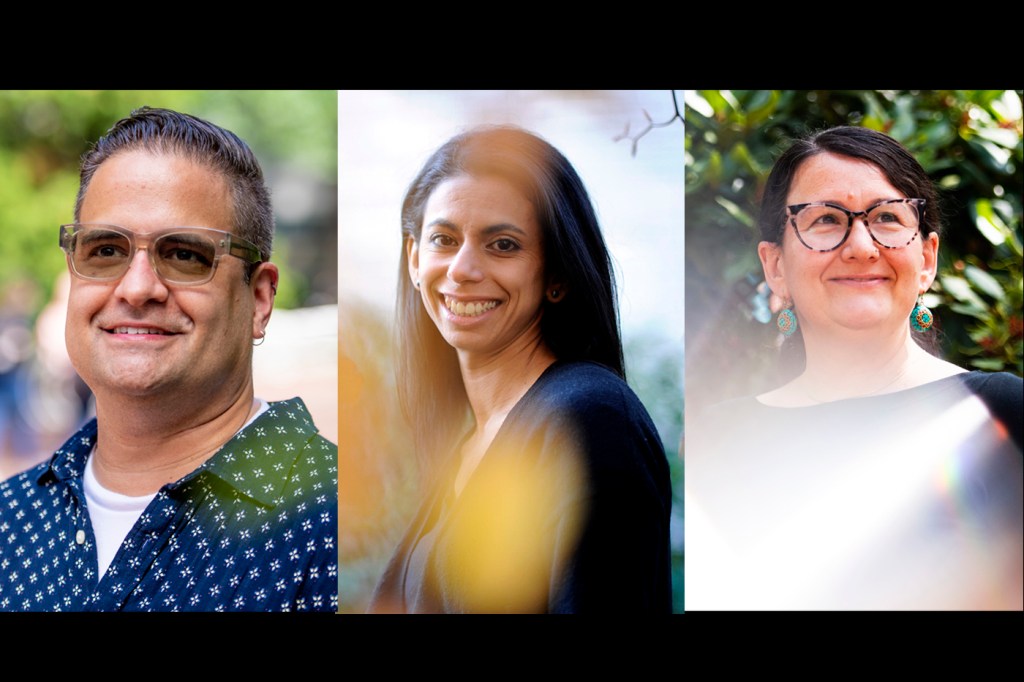Boston becomes experiential learning lab in Northeastern humanities institute

What was Boston’s role in the slave trade? If you took a tour of the city, how would you know?
The answer might surprise you: A single plaque at the end of the Long Wharf memorializes Boston’s place in the Middle Passage.
The understated memorial is a testament to “how bad of a job we do noting that slave ships landed in the Seaport area and brought thousands of slaves in the United States,” says Serena Parekh, professor of philosophy at Northeastern’s College of Social Sciences and the Humanities. “I had no idea even though I’ve lived here for 22 years now.”
The monument became an important symbol for scholars who took a tour of the city this month as part of the three-week Engaging Geography in the Humanities Institute.
Funded by the National Endowment for the Humanities and held on Northeastern’s Boston campus, the Institute brought together 25 scholars from across the country for presentations, excursions in the Boston area and hands-on workshops. The goal was to teach scholars who study history, philosophy, literature and other humanities disciplines how to integrate geography and ideas of space into their teaching and research, using the city of Boston itself as a case study.
The Institute, which was a follow-up from one held in 2017, was entirely Northeastern-led, with Parekh, professor of Africana Studies Angel Nieves, and associate professor of Sociology Liza Weinstein acting as co-directors. Uta Poiger, the dean of the College of Social Sciences and Humanities, gave the opening address, emphasizing the institute’s alignment with the university’s mission.
“I see this institute very much in line with our experiential liberal arts mission, which is about integrating experiential learning with academic pursuits and always making experiential learning key,” Poiger says.
By hosting the Institute in Boston, the co-directors were able to use the city as a laboratory to experiment with ideas of geography and space. Through tours of the city and the Northeastern campus, they explored questions like, how is history marked in a space? What is the dominant historical narrative being told in Boston through these markers? How does early geography of the Northeastern area shape the campus as it currently stands?
To answer the last question, they followed the tributaries of the Stony Brook River that used to run through campus and were buried in the 19th century, and discovered why the streets curve the way that they do. Discoveries like this “help participants understand the traces or residues that earlier urban histories leave in the city itself or in locations,” Weinstein says. “The idea that the past doesn’t actually go away.”
Similarly, they explored how the history of the slave trade in Boston, and how that history is told, is reflected in the city as a space.
The Long Wharf monument is not notable compared to other placards in the area, which is telling, the co-directors say.
“We played a huge role in the process of bringing slaves in, and the reason most people aren’t aware of that is very intentional,” Parekh says.
“[Boston has] been so long obsessed with the Revolutionary [War] period and has very conveniently overlooked and narrowly defined how the slave trade was and is depicted here in Boston,” Nieves says. “We don’t really get an understanding of that.” He notes that 60 slaves once lived at a nearby historical site.
The institute was an opportunity to showcase Northeastern scholars as leaders in the digital humanities; nearly a dozen faculty members and graduate students from Northeastern were allowed to showcase their work in this area, along with Olly Ayers from Northeastern University-London. The co-directors also engaged with the community by partnering with nearby businesses such as the West End Museum, North End Boston Food Tour, and Live Like a Local Tours.
Attendees, meanwhile, came from across the country, representing a diverse array of community colleges, historically black colleges and universities, and major public and private universities.
No matter where they arrived from, however, they sang praises about the Institute—feedback has been “overwhelmingly positive,” Parekh says.
“The experience has already had a significant impact on what I am envisioning for my upcoming teaching practices and on what new iterations of my scholarship I can produce,” one participant wrote in a survey. “I am excited for the possibilities!”
“I have fallen in love with Northeastern. Period,” said another.
For media inquiries, please contact media@northeastern.edu.






